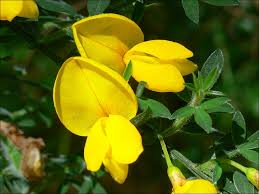Cytisus scoparius
“Scotch Broom”
PAPILIONACEAE (previously Rosaceae)
Deciduous Shrub – Noxious Weed
(Evergreen in warmer conditions)
Zone: every
Native habitat : Europe
Conditions
Soil: average – any –
Moisture: drought tolerant
Light: full sun to part shade
Exposure: easily grows in disturbed areas
Plant size (h x w): 3′ – 10′ x 10′
Other: can grow in many poor conditions
 Aesthetic
Aesthetic
Shape/stem: stiffly upright, round, angular stems and branching,
Leaf: small, compound, alternate, flexible, lancolate, entire, trifoliate, green
Flower: solidary, perfect, 5 petals, yellow, fragrant, pea-like
Bloom: May to June
Other: deep taproot
Treatment (how to remove…)
If you see it, dig it out or dig a small hole around stem (at least 2-3″)and cut it bellow the surface of the soil, likely for a few years in a row. (If you just cut it down, it will only grow more.) Then be sure to treat it as toxic waste and burn it or throw in garbage.
Pull any seedlings as you see them.
Always try to remove before seed it set.
Propagate: introduced weed; seed profusely
Uses
Medicinal: may be some traditional medical uses; toxic if ingested
Other: broom, baskets, dyes, thatch

Vulnerabilities
Pests and disease: none significant
Deer resistant: yes
The lack of vulnerabilities is a big reason this shrub is so invasive; there is nothing to stop it. Some biological controls are being introduced to try to stop it: beetles and mites and goats are some examples. Also release a phototoxin in soil that kills what grows near it.

Interest
Local info,: introduced noxious weed; will take over native plants
Nature: tough, invasive, adaptable, hardy, prolific seeder with no pests, disease, or threats to stop it
Identification (key features): Invasive weed; stems angular; leaves small, trifoliate; flowers bright yellow, very abundant in May-June; fruit is legume, long white hairs when immature.

Interesting facts: Highly aggressive and invasive all the way from New Zealand to California; Was sold as a landscape plant well into the 80’s as a hwy plant and to stabilize slopes.
Comments: Out competes on a global scale with such a deep tap root, ability to grown in disturbed places, prolific seeds, and general lack of pests and threats.
